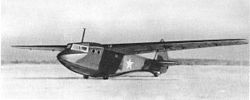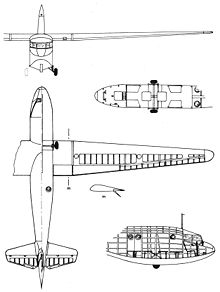Antonov A-7
| Antonov A-7 (RF-8) | |
|---|---|

|
|
| Type: | Glider |
| Design country: | |
| Manufacturer: | |
| First flight: |
August 28, 1941 |
| Commissioning: |
1942 |
| Number of pieces: |
about 400 |
The Antonov A-7 ( Russian Антонов А-7 ), project designation RF-8 (РФ-8) was a cargo glider manufactured in the Soviet Union . The development took place in OKB -115 near Jakowlew , but the designer was Oleg Antonow .
history
The impetus for the development was a tender for a military glider from September 1940. Oleg Antonov participated with his RF-8 (RF for Red Front ), which was based on the RF-7 from 1938. In December, his design was declared the winner and the construction of a prototype was commissioned. The Lithuanian Kaunas was selected as the production location , but the attack on the Soviet Union prevented production and the factory was relocated to Tushino due to the German advance , where construction was completed on August 28, 1941 and test pilot W. Rastorgujew made the first flight on September 2 could carry out by winch launch . On September 18, the test program was ended and series production was prepared. However, the approach of German troops again prevented production and the plant was evacuated to Tyumen in western Siberia. It was not until the end of 1941 that series production of the cargo glider, now known as the A-7, could begin. In March 1942 the first copies were delivered to the air force , which equipped two regiments with them. Due to the demand, a second production site was built in Alapayevsk . The machine turned out to be just as useful as the Airspeed Horsa or DFS 230 . DB-3 or SB-2 were usually used as tow planes .
The machine was used to supply partisans or for sometimes spectacular commando operations into the enemy hinterland, in which captured Ju 87 , Ju 88 or He 111 were also used as tow planes. British hurricanes are also said to have been suitable for this purpose and used accordingly.
How many A-7s were built can no longer be clearly proven, ultimately a number between 400 and 500 appears most likely.
construction
The shoulder decker had a retractable landing gear with a rigid tail spur. The cross-section of the fuselage was rectangular. A wooden skid was installed under the front of the machine. The wheels could be fitted with snow runners . The machine consisted of a wooden frame and was covered with fabric. The tail unit was conventional, the elevator and rudder were trimmable . The outer wings were behind the flaps , which were designed as expanding flaps, removable for transport. Spoilers could be extended from the wing. In addition to the pilot, the aircraft could transport six fully equipped soldiers. A door was installed on the right behind the wing and on the left behind the cockpit to allow the machine to be exited quickly.
Versions
- A-7U : School version, U stands for Uchebny (Учебный), training
- A-7Sch : speak Scha ; Version with additional seat for a navigator (Schturman, Штурман)
- A-7B : Version with tank in the fuselage as a fuel transporter, B stands for Bensinonosjez (Бензиноносец), petrol carrier; only prototype
Technical specifications
| Parameter | Data |
|---|---|
| constructor | Oleg Antonov |
| crew | 1 |
| Passengers | 6 fully equipped airborne soldiers |
| span | 19.00 m |
| length | 11.50 m |
| height | 2.70 m |
| Wing area | 23.20 m² |
| Wing loading | 27.0-37.0 kg / m² |
| payload | about 800 kg |
| Takeoff mass | normal 1,100 kg maximum 1,755 kg |
| Top speed | 300 km / h |
| Towing speed | 200 km / h |
| Glide ratio | 23 at 105 km / h |
literature
- Rudolf Höfling: Antonov . Since 1946. Motorbuch, Stuttgart 2013, ISBN 978-3-613-03518-8 , p. 25 .
- Vladimir Kotelnikov: Antonov A-7 . In: Aviation Classics . No. 2/2016 . Motor Presse, Stuttgart 2016, p. 50-53 .
Web links
- А-7 (Рот Фронт-8). Retrieved January 12, 2016 (Russian).

